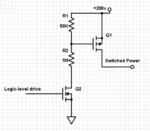BKI
Member level 1
Hi,
i like to add a virtual ground between two Switches.
The idea is, i connect two NMOS in series connected on the source sides.
Then i want to add a virtual ground between the Switches. (see pic)
Why i need this? Because of my limitations.
Vgs,max=5V, Vds,max=300V, Vgate,max=5V, Vin=200V , Vout should be 200V.
Therefore, my Vsource should be 0V.
How can i implement this the simplest way, without using an OpAmp?

i like to add a virtual ground between two Switches.
The idea is, i connect two NMOS in series connected on the source sides.
Then i want to add a virtual ground between the Switches. (see pic)
Why i need this? Because of my limitations.
Vgs,max=5V, Vds,max=300V, Vgate,max=5V, Vin=200V , Vout should be 200V.
Therefore, my Vsource should be 0V.
How can i implement this the simplest way, without using an OpAmp?



